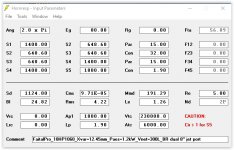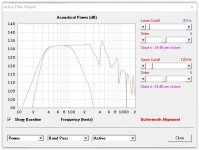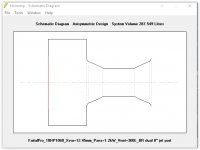18sound 18TLW3000 -- with very unique features -- is getting rave reviews from the PA pros in Germany, it is been said to top the B&C 18SW115 and that says something. If the Klippel data posted by 18sound is real this surely is a most competent driver.
The main thing driver Qts is responsible for which cannot be changed by proper EQ is the damping of the Helmholtz resonantor. Too low Qts will be underdamped and the range of the port output frequencies will be very narrow, really spiky response. Too high Qts will overdamp the Helmholtz and produce a wide but shallow peak of port output and cone excursion will not be notched as much as with lower Qts. But unless you totally loose the notch that is not a problem, rather the contrary because large signal behaviour tends to be better quite often.In that case I would go for LF woofer with a Qts between 0.28 and 0.33 (0.31 is considered ideal for a reflex system).
I've played a lot with variable amplifier output impedance so that effective Qts can range from something as low as 0.2 up to 1 and more, with any giver driver, and most of the time I found higher Qts than the textbook optimum of 0.31 perform better at large signal because the Helmholtz damping does not increase that much when the driver maxes out (droop of electrical damping).
Thanks chris, that sub is a little expensive. But maybe worth it. Upon hrs of reading it looks like the Keystone 18 might be worth pursuing. I want a somewhat musical sub and have seen some reviews of the keystone saying how great it sounds. Build complexity isnt bad either. I see lots of speculation and sims but very few actual build reports.
Hi treukauf,
Post #23: "...looks like the Keystone 18 might be worth pursuing..."
http://www.diyaudio.com/forums/subwoofers/185588-keystone-sub-using-18-15-12-inch-speakers-10.html Post #99...106...114...
Gotta run,
Regards,
Post #23: "...looks like the Keystone 18 might be worth pursuing..."
http://www.diyaudio.com/forums/subwoofers/185588-keystone-sub-using-18-15-12-inch-speakers-10.html Post #99...106...114...
Gotta run,
Regards,
Hi KSTR,
I do miss a few things in your explanation regarding damping: power losses, VC temp, clustering (stacking), endfire setups, difficult acoustic environments where +140 dB PA’s usually in operate and why most OEM manufacturers that produce ported subs for larger events, are 'overdamped' in your view while higher Qts drivers are usually economically more interesting?
Cheers,
Djim
I do miss a few things in your explanation regarding damping: power losses, VC temp, clustering (stacking), endfire setups, difficult acoustic environments where +140 dB PA’s usually in operate and why most OEM manufacturers that produce ported subs for larger events, are 'overdamped' in your view while higher Qts drivers are usually economically more interesting?
Cheers,
Djim
Last edited:
Bassreflex w/ Jet Port in Hornresp
Hi Y'all,
This is just another example of a bass reflex done in Hornresp using the horn design feature to build a port with extended inlet and outlet flares to reduce the particle velocity. Just for a different driver I used 2ea. FaitalPRO 18HP1060.
Regards,
P.S.: Maybe as a PPSL?
Hi Y'all,
This is just another example of a bass reflex done in Hornresp using the horn design feature to build a port with extended inlet and outlet flares to reduce the particle velocity. Just for a different driver I used 2ea. FaitalPRO 18HP1060.
Regards,
P.S.: Maybe as a PPSL?
Attachments
Last edited:
In my reading of the ppsl, xo1c, and keystone. Which are still over my head (even being a mech engineer and studying sound some haha) i havent seen anything where the ppsl offered much performance advantage over a keystone. The personal reviews of people enjoying the high quality sound and its easier to build than an xo1c are leading me to keystone.
PPSL is a ported box that'll cancel some of the even-order harmonic distortion. Its still subject to the same compromises as a ported box (port compression, etc).
Roughly speaking, a tapped horn will be as big as two reflex cabinets, and have the output of two reflex cabinets. You only need one driver for the TH, though.
If it was mine, I'd get the best 18" driver you can get your hands on, and put it in the Keystone or similar. One keystone would equal a pair of the same 18"s in ported boxes, and a good modern 18" will happily beat an old-school 2x18" cab. ie, the Keystone, with a good driver, should take on a pair of old 2x18"s and win.
You're gonna need some serious power, though.
Chris
Roughly speaking, a tapped horn will be as big as two reflex cabinets, and have the output of two reflex cabinets. You only need one driver for the TH, though.
If it was mine, I'd get the best 18" driver you can get your hands on, and put it in the Keystone or similar. One keystone would equal a pair of the same 18"s in ported boxes, and a good modern 18" will happily beat an old-school 2x18" cab. ie, the Keystone, with a good driver, should take on a pair of old 2x18"s and win.
You're gonna need some serious power, though.
Chris
Thats where im ending up too. I appreciate the reinforcement. Im looking at the b&c 18sw115-4 that art used. I dont want any variables... and a behringer nu3000dsp to drive it. Unless someone can convince me i need a fancier amp? Its rated 2000 watts rms at 4 ohm bridged, but i see reports thats a lie and its more like 700watts rms. Any guru advice here on amps?
That bench test was the NU6000. The NU3000 will do a touch over a kilowatt a side into 2ohm, so 2kw bridged into 4 is about right.
Depending on your music genre, you might get away with more peak power, but maybe not by much. The NU3000 is a good choice if you only ever want one sub. If you might ever build another (or just want a spare amp channel), the NU6000 doesn't cost much more, and gives the same power as a pair of NU3000s in one box.
Chris
Depending on your music genre, you might get away with more peak power, but maybe not by much. The NU3000 is a good choice if you only ever want one sub. If you might ever build another (or just want a spare amp channel), the NU6000 doesn't cost much more, and gives the same power as a pair of NU3000s in one box.
Chris
I like having separate amps in case of a failure. Its all edm which runs bass about as hard as possible. Im going to build this next week. There any other parts im forgetting about for the keystone? Driver, amp, good wires, tnuts for mounting the sub, handles? Also last time we tied our qsc system into a behringer amp ( daisychained in to the speakers we had bad hum. Is a hum eliminator usually the ticket? ( we run straight out of the pioneer ddjsr controller into the qsc's. No mixer)
Treukauf,1)In my reading of the ppsl, xo1c, and keystone. Which are still over my head (even being a mech engineer and studying sound some haha) i havent seen anything where the ppsl offered much performance advantage over a keystone.
2) I like having separate amps in case of a failure. Its all edm which runs bass about as hard as possible. Im going to build this next week. There any other parts im forgetting about for the keystone? Driver, amp, good wires, tnuts for mounting the sub, handles?
3)Also last time we tied our qsc system into a behringer amp ( daisychained in to the speakers we had bad hum. Is a hum eliminator usually the ticket? ( we run straight out of the pioneer ddjsr controller into the qsc's. No mixer)
1) A PPSL's only advantage over a standard BR cabinet is the reduction of even order harmonic distortion, and a reduced frontal area compared to front mounted cones. I'll be replacing my PPSL with Keystones ( a new B-Low version) again shortly, re-using the PPSL drivers.
2) Redundancy is always a good choice, whatever amplifiers you are using. The standard Keystone did not use any handles, though the new B-Low version will, primarily as a guy point for ratchet straps to the top cabinet. The handles will be built in, not separate hardware.
3) "Bad hum" is usually indicative of a ground loop (two differing impedance paths to earth ground), which generally can be eliminated by lifting (eliminating) the pin 1 connection at one end of the signal cable.
The Ebtech "Hum Eliminator" is a decent device, though the isolation transformers used in it are a little bit light for LF reproduction, they will saturate at line level peaks with VLF.
Transformers are a good thing to have when you don't have time to sort out what is causing the ground loop, and there are certain pieces of gear who's grounding schemes are improper, no wiring configuration will eliminate the "built in" ground loops they have other than iso transformers.
Art
- Status
- Not open for further replies.
- Home
- Loudspeakers
- Subwoofers
- 18 inch BR questions and driver preferences.


